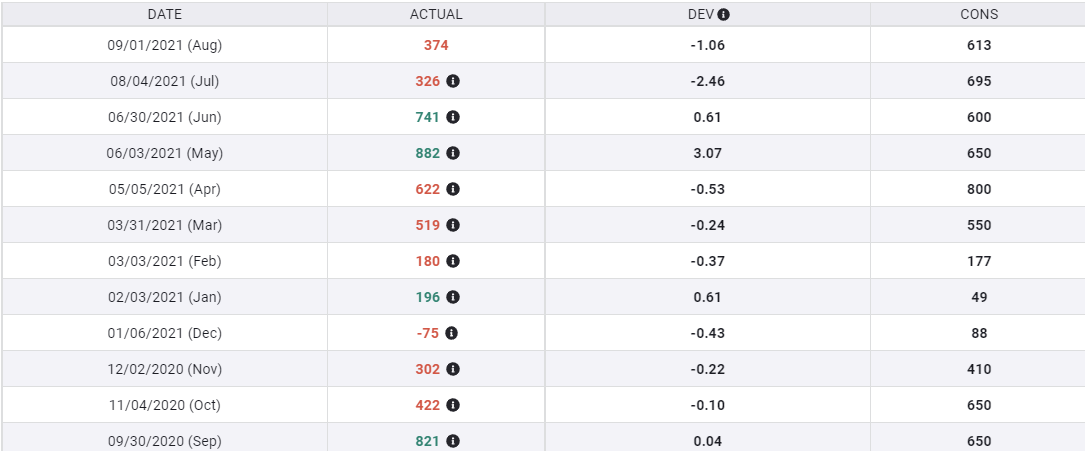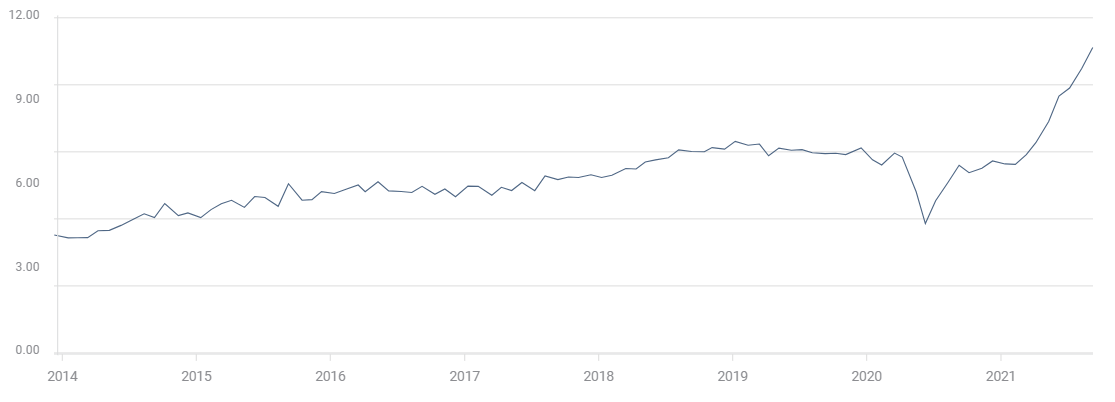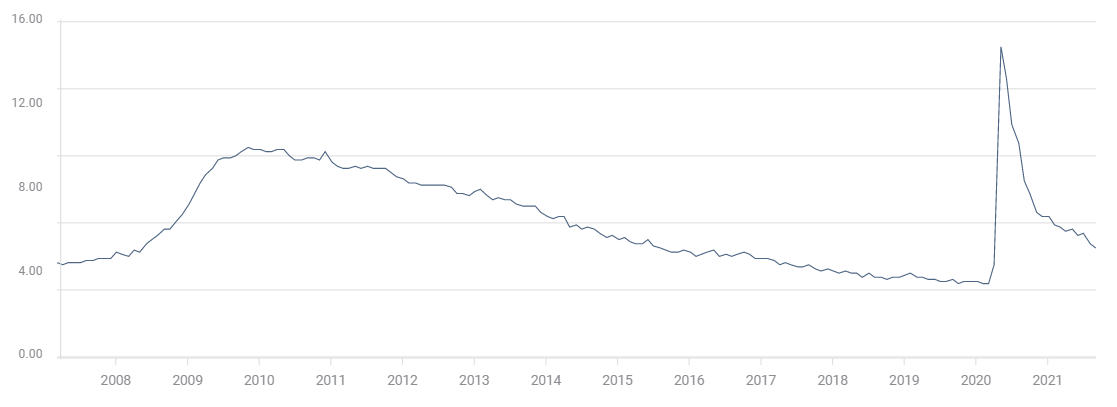- ADP private payrolls expected to add 430,000 in September.
- July and August ADP payrolls produced about half the expected hires.
- September Nonfarm Payrolls key to Fed’s pending taper.
The Federal Reserve has promised a bond taper before the end of the year. There are two FOMC meetings left in 2021, November 3 and December 15. A strong September payroll report, after August’s disappointment, would help cement that announcement for November.
Private payrolls from Automatic Data Processing (ADP) have a weak monthly correlation with the Labor Department's national figures. They are, however, timely, coming two days before the government figures and they are the largest countrywide numbers aside from the Nonfarm Payroll (NFP) report itself.
The US corporate clients of ADP are forecast to have added 430,000 employees in September.
ADP and NFP
Over the past six months markets received no warning from the ADP numbers that national Nonfarm Payrolls were going to be substantially different from the consensus forecasts.
In April, NFP was projected to increase to 978,000 from March’s 785,000. Instead, the economy delivered just 269,000 new positions. The ADP Employment Change Report that month rose to 662,000 from 519,000.
ADP
In July, NFP rose to 1.053 million, the best total since August 2020, from June’s 962,000. In contrast, the ADP July figure tumbled to 326,000 from 741,000.
Finally, last month, US payrolls fell by 818,000 to 235,000. The ADP result for August rose slightly to 374,000 from the above 326,000.
NFP
FXStreet
Looking at the relation another way, in the five changes over the last six months, NFP and ADP have moved in the same direction once, in May.
Over longer periods the trend correlation between the NFP and ADP is quite good. Both reports plunged in April 2020 and saw extensive rehiring in the following three months and each dipped into the negative last December.
US labor market
The US labor market has been presenting some puzzling statistics for several months.
Chief among the discrepancies unanswered by standard analysis has been the record number of jobs on offer, almost 11 million in July, compared to August's anemic hiring of 235,000.
Job Openings and Labor Turnover Survey (JOLTS)
FXStreet
Initial Jobless Claims present another contrast. Despite the huge number of unfilled positions, the weak hiring in August and the expected mediocre NFP for September, Initial Jobless Claims have increased for three straight weeks. Requests for jobless benefits have gone from 312,000 in the week of September 3, a pandemic low, to 362,000.
Another oddity is the unemployment rate. Ignoring the variation in hiring this year, the U-3 rate has fallen every month from 6.3% in January to 5.2% in August.
US Unemployment Rate (U-3)
FXStreet
One explanation for the apparent reluctance of workers to return to their jobs has been the extended federal unemployment benefits granted by the Biden administration. Those supplemental payments expired in the first part of September, so a large return to work might be expected. Yet the consensus NFP estimate is just 450,00, hardly a wave.
Perhaps the best answer is that the pandemic and its responses have presented such a novel economic situation that the standard statistics, their indications and analysis, have been able, at best, to give only a partial picture of what is occurring in the labor market.
Conclusion: Tapering when?
Markets are waiting for the US central bank to confirm its bond program taper. Anything that points in that direction will support Treasury rates and the dollar.
Labor market conundrums may be interesting to economists but markets trade on traditional information and its impact on policy.
The Fed may be uncertain about the advisability of extended unemployment insurance. The governors may not understand why more people have not returned to work, or whether rising wages will attract workers.
They do know that strong NFP results will make the taper far easier to explain and justify.
The ADP report may not be a reliable indicator for US payrolls, but as in the newspaper cliche, sometimes you have to go with what you’ve got.
Information on these pages contains forward-looking statements that involve risks and uncertainties. Markets and instruments profiled on this page are for informational purposes only and should not in any way come across as a recommendation to buy or sell in these assets. You should do your own thorough research before making any investment decisions. FXStreet does not in any way guarantee that this information is free from mistakes, errors, or material misstatements. It also does not guarantee that this information is of a timely nature. Investing in Open Markets involves a great deal of risk, including the loss of all or a portion of your investment, as well as emotional distress. All risks, losses and costs associated with investing, including total loss of principal, are your responsibility. The views and opinions expressed in this article are those of the authors and do not necessarily reflect the official policy or position of FXStreet nor its advertisers. The author will not be held responsible for information that is found at the end of links posted on this page.
If not otherwise explicitly mentioned in the body of the article, at the time of writing, the author has no position in any stock mentioned in this article and no business relationship with any company mentioned. The author has not received compensation for writing this article, other than from FXStreet.
FXStreet and the author do not provide personalized recommendations. The author makes no representations as to the accuracy, completeness, or suitability of this information. FXStreet and the author will not be liable for any errors, omissions or any losses, injuries or damages arising from this information and its display or use. Errors and omissions excepted.
The author and FXStreet are not registered investment advisors and nothing in this article is intended to be investment advice.
Recommended Content
Editors’ Picks

EUR/USD maintains its constructive tone near 1.1400
EUR/USD remains well bid in the proximity of the 1.1400 hurdle on Thursday, deriving support from the renewed selling pressure in the US Dollar as investors continue to assess the ongoing absence of further progress in the US-China trade conflict.

GBP/USD appears sidelined around 1.3300, USD remains offered
GBP/USD holds its ground near the 1.3300 mark on Thursday amid a strong rebound in the broader risk-linked universe, all against tha backdrop of renewed weakness around the Greenback and steady uncertainty over US–China trade relations.

Gold eases from tops, back near $3,300
Gold manages to regain composure and reverses two daily drops in a row, currently approaching the $3,300 mark per troy ounce following the earlier bull run to the boundaries of $3,370. Furthermore, XAU/USD attracted safe-haven flows amid renewed concerns of a US-China trade flare-up.

Bitcoin Price corrects as increased profit-taking offsets positive market sentiment
Bitcoin (BTC) is facing a slight correction, trading around $92,000 at the time of writing on Thursday after rallying 8.55% so far this week. Institutional demand remained strong as US spot Exchange Traded Funds (ETFs) recorded an inflow of $916.91 million on Wednesday.

Five fundamentals for the week: Traders confront the trade war, important surveys, key Fed speech Premium
Will the US strike a trade deal with Japan? That would be positive progress. However, recent developments are not that positive, and there's only one certainty: headlines will dominate markets. Fresh US economic data is also of interest.

The Best brokers to trade EUR/USD
SPONSORED Discover the top brokers for trading EUR/USD in 2025. Our list features brokers with competitive spreads, fast execution, and powerful platforms. Whether you're a beginner or an expert, find the right partner to navigate the dynamic Forex market.



